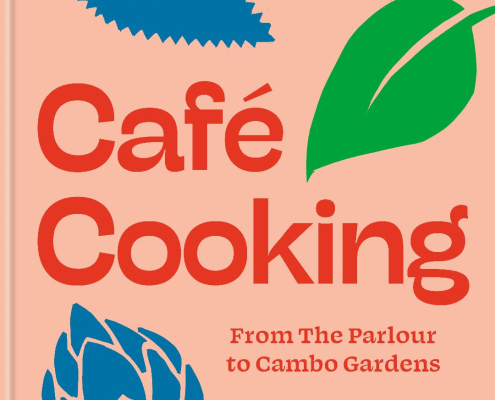Kitchen Press is a new, independent publisher specialising in food writing. It aims, through lovingly crafted bespoke cookbooks, to connect innovative chefs, expert food writers and independent restauranteurs with customers and others around the world who love food.
We believe that the whole experience of reading about food and cooking should be as pleasurable and inspiring as eating it, and we want to help promote the people and places doing that best.


Flavoured Butters
From The Seafood Shack – Food & Tales from Ullapool
by Kirsty Scobie & Fenella Renwick
Flavoured butters are really quick and easy and are something Kirsty & Fenella use all the time to boost flavour and jazz up their seafood. In the Shack they use them instead of plain butter in most of their dishes. And they’re not just good for fish dishes – put a slice on a steak after cooking, stick some in your baked potatoes, stir into pasta. Whatever you’re cooking, these little flavour bombs will take it to a different level of tastiness. You can store them in the fridge for weeks or pop them in the freezer to take out when needed. Some of the flavours Kirsty & Fenella make at the shack include Chilli, Paprika and Lime; Mixed Herb; Lemon, Caper and Dill; Pesto and Saffron and Sweet Shallot but here’s the recipe for one of our favourites, Roast Garlic and Chive.
Roast Garlic & Chive Butter
To make your butter
First roast the garlic.
Preheat the oven to 120°C. Slice the bottom off the garlic bulb so the ends of the cloves are exposed. Now get a sheet of tin foil, scrunch it into a small bowl, and put in your olive oil and a good amount of salt and pepper. Put your garlic bulb on top of the oil, cut side down. Wrap your tin foil over the top of the bulb to seal in a parcel and cook in the oven for around 45 minutes to an hour.
Check if the garlic’s ready by removing from the oven and giving it a wee squeeze – it should be super soft. If it’s not, put it back in the oven for another ten minutes or so and cook until soft but make sure you don’t burn it. Remove the garlic from the tin foil parcel. Once it’s cool enough to touch, flake off any loose peel and squeeze the soft garlic cloves out of the skin. They should slide out easily.
Place the roasted garlic flesh in a bowl with the softened butter and the chives and mix with a wooden spoon. We always season our butters with just a little amount of salt and some fresh black cracked pepper.
To roll your butter
Get some clingfilm and cut it about the size of an A3 sheet of paper. Lie this out flat on your worktop and spoon the butter mixture across the middle in a horizontal line, leaving about
a hand space on either side. Now hold the corners of the clingfilm closest to you and fold over the butter. Run your hands along the butter to the edges to smooth out and remove any air holes. Twist the clingfilm at either end and gently roll your butter to form a good cylinder shape. Perfect for storing in the fridge and freezer! Now why not try some more flavoured butters with your own favourite seasonings?
Buy The Seafood Shack – Food & Tales from Ullapool here
Soup is Simple
‘Soup is simple!’ says Fraser Reid. Well, he would know – he is the author behind one of our favourite and perenially popular titles, Seasonal Soups. Fraser runs Fraser’s Fruit & Veg in Dundee which focuses on supplying the most local produce that he can source. The aim, he says, is ‘to get produce harvested that morning and onto the shelves within the next couple of hours’ from local farms, allotments and even local gardens.
Here is Fraser’s vegan-friendly recipe for Butternut Squash, Coconut and Apple Soup which makes very tasty use of some autumnal staples.
Butternut Squash, Coconut & Apple Soup
The apple in this soup acts as a sweetener and can easily be replaced by using a pear, peach or apricot (depending on the time of year).
Ingredients
Method
Heat a pot on a medium-low heat and add the oil or butter. Fry the onion, carrot and garam masala for 5-10 minutes.
Add the squash and apple and continue to cook for 5 minutes.
Pour in 1.2 litres of boiling water and add the stock cubes and the creamed coconut, stirring to make sure it dissolves. Bring to the boil, then turn down the heat and simmer for 20 minutes.
Blend the soup until smooth, then season to taste.
Serves 4
Buy Seasonal Soups here
How to Dissect a Crab
Do not be afraid of crabs! Once you have mastered the art of how to dissect a crab, then a world of amazing recipes from crab bisque to hot dressed crab to creamy crab linguine and beyond opens right up for you. So no need to worry if you can’t tell your dead man’s fingers from your white meat because The Seafood Shack-ers Kirsty & Fenella are here to tell you exactly what to to!
Take One Cooked Crab
Now…
Get yourself a copy of The Seafood Shack – Food & Tales from Ullapool and make something delicious!